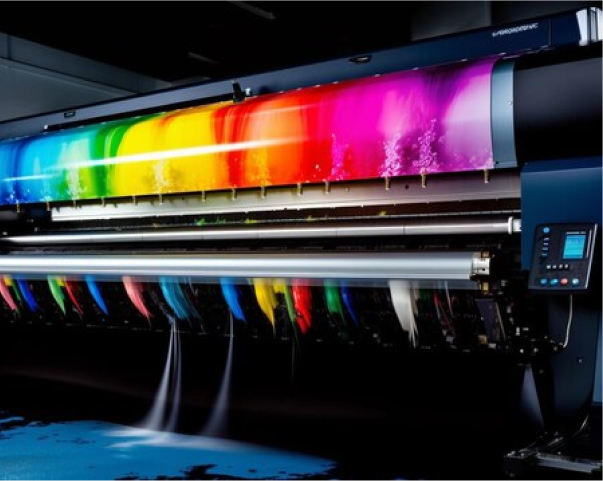In the world of digital printing, it is crucial to achieve accurate and vibrant colors for producing high-quality prints. An importance concept to consider toward this is color space, a fundamental aspect of digital printing that influences how colors are represented and reproduced in final prints. In this short comprehensive guide, we'll talk about what color space is, its significance in digital printing, and how to navigate the various color spaces to achieve optimal results in your printing business.
What is Color Space?
Color space, also known as color model or color gamut, is a mathematical representation of colors within a specific color model. It defines the range of colors that can be accurately represented or reproduced in a digital system, such as a camera, monitor, or printer. Color spaces are commonly defined by a combination of primary colors and color components, which determine the color gamut or the range of colors represented within that space.
Common Color Spaces
There are three basic color spaces we deal with in the digital graphics industry, and each one of them has its unique characteristics, applications, and advantages, that makes them an essential tools for digital design, image processing, and printing. Let´s define them:
RGB (Red, Green, Blue)
Probably the most popular one, RGB is an additive color model regurlary used in digital devices such as monitors, cameras, and scanners. In RGB color space, colors are represented as red, green, and blue light and its different combinations. The RGB color model is device-dependent, this means that the color gamut varies depending on the characteristics of the device displaying or capturing the image, that’s why you can see the same image in your laptop and cellphone and the may look different in color. Some popular RGB color spaces are sRGB, Adobe RGB, and ProPhoto RGB, and each one has its own gamut size and suitability for different applications.
CMYK (Cyan, Magenta, Yellow, Black)
Another popular color space, CMYK is a subtractive color model used primarily in printing processes. In CMYK color space, colors are represented as combinations of cyan, magenta, yellow, and black inks. In constrast with RGB color space, which adds light to create colors, CMYK subtracts light to produce colors by absorbing certain wavelengths of light. CMYK color spaces are typically device-independent and are used to prepare images for printing on various substrates.
Lab (CIE Lab*)
Lab is a device-independent color space defined by the International Commission on Illumination (CIE), although it’s not so used as the previous two, it is also important. Lab color space is designed to encompass the entire range of human vision and is often used as a reference space for color measurements and conversions. Lab color space consists of three components: L* (lightness), a* (green to red), and b* (blue to yellow).
Importance of Color Space in Digital Printing
As we mentioned, in digital printing, color space determines how colors are interpreted and reproduced from file to final print. By understanding color space and its implications, printers can accurately interpret color information, maintain consistency across different devices, and achieve optimal color reproduction in their prints. Here are some important concepts to know:
Color Accuracy: Color accuracy in digital printing refers to the precision in reproducing colors true to their original appearance, ensuring consistency and fidelity in the printed output. By matching the color space of the source image to the output device, printers can minimize color shifts and discrepancies, resulting in more accurate and consistent prints.
Gamut Mapping: This term refers to the process of adjusting colors to fit within the printable color range (gamut) of a specific device, ensuring accurate reproduction across different output devices. Different devices have different ranges of reproducible colors, also known as color gamuts. When transferring images between devices with different gamuts, gamut mapping techniques adjust the colors to fit within the destination device's gamut. Understanding color spaces helps printers optimize gamut mapping processes in order to achieve color accuracy.
Workflow Efficiency: Establishing a standardized color space for digital printing streamlines the workflow and ensures consistent color reproduction across multiple projects and printing devices. By adopting industry-standard color spaces such as sRGB or Adobe RGB, printers can simplify color management tasks and reduce the likelihood of color-related errors or inconsistencies.
Choosing the Right Color Space for Digital Printing
Selecting the appropriate color space for digital printing depends on various factors, including the intended use of the printed materials, the capabilities of the printing device, and the preferences of the end user. Here are some considerations for choosing the right color space:
Application Requirements: Different applications may have specific color space requirements based on their intended use. For example, web graphics and digital displays often use the sRGB color space, while professional photography and high-end printing applications may benefit from the wider gamut of Adobe RGB or ProPhoto RGB.
Device Characteristics: It is important to consider the color capabilities and characteristics of the printing device when choosing a color space. Printers with larger gamuts may be able to reproduce a wider range of colors, allowing for more vibrant and accurate prints. However, it's essential to ensure that the chosen color space is supported by both the input and output devices to avoid compatibility issues.
Output Medium: The type of substrate and printing process used can also influence the choice of color space. For example, CMYK color spaces are typically used for offset printing processes, while RGB color spaces may be preferred for digital and wide-format printing applications. Consider the characteristics of the output medium and the desired print quality when selecting a color space.
Implementing Color Management Techniques
Once you've chosen the appropriate color space for your digital printing project, your must implement color management techniques to ensure consistent and accurate color reproduction. Here are some best practices for implementing color management in digital printing:
Calibration and Profiling: It’s necessary to regularly calibrate and profile your input and output devices to ensure accurate color reproduction. Use calibration tools such as spectrophotometers or colorimeters to measure and adjust device settings, and create custom color profiles tailored to your specific equipment and printing conditions.
Soft Proofing: Use soft proofing techniques to simulate how colors will appear in the final print before sending files to the printer. Soft proofing allows you to preview color adjustments and identify potential issues such as color shifts or clipping, enabling you to make informed decisions and optimize print quality.
Color Conversion: Convert images between different color spaces using color management software or conversion tools. When converting between RGB and CMYK color spaces, use rendering intents such as perceptual or relative colorimetric to preserve color accuracy and minimize color shifts.
Monitor Calibration: Ensure that your computer monitor is properly calibrated to accurately display colors. Use monitor calibration tools to adjust brightness, contrast, and color settings, and regularly recalibrate your monitor to maintain consistency over time.
Proofing and Testing: Before finalizing prints, conduct test prints and proofing to evaluate color accuracy and make any necessary adjustments. Compare printed proofs to reference standards and adjust color settings as needed to achieve the desired color reproduction.
Now that we know the importance of color space in our printing business, we can follow the best practices for color management and choose the appropriate color space for each project in order to make our printers work at their full potential and deliver stunning prints that fullfil every customers need.







